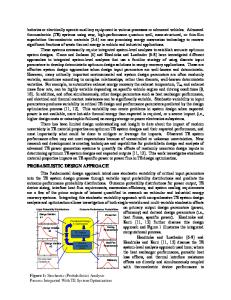High Efficiency Thermoelectric Power Conversion
- PDF / 80,709 Bytes
- 6 Pages / 612 x 792 pts (letter) Page_size
- 65 Downloads / 417 Views
0886-F12-03.1
High Efficiency Thermoelectric Power Conversion
Donald F. Byrnes and Ben Heshmatpour Teledyne Energy Systems, Inc. Hunt Valley, MD 21031
ABSTRACT
Recent efforts at Teledyne Energy Systems, Inc. have lead to significant improvements in thermoelectric (TE) materials and power conversion devices. A number of improved formulations have been identified for standard n-type PbTe and p-type TAGS alloys. The preliminary test results appear to show nearly a 50% increase in the dimensionless figure-ofmerit, ZT, for these two alloys. The new TE material formulations also exhibit a lower sublimation rate which is likely to allow use of these materials at higher heat source temperatures and thus result in higher Carnot efficiencies. The combination of higher ZT and higher Carnot efficiency allows achievement of exceptionally high thermoelectric conversion efficiencies through small changes to proven technology. For example, a thermoelectric conversion device which uses segmented BiTe/modified PbTe/modified TAGS thermoelectric couple design and operates between 300 °K and 900 °K will have a conversion efficiency of approximately 16.2%. Effort is continuing to confirm the preliminary test results and validate the materials fabrication processes. A number of improvements have also been made in the TE device fabrication processes and assembly techniques which have reduced the internal thermal and electrical losses, increased conversion efficiency, enhanced reliability and reduced manufacturing cost for the thermoelectric devices.
INTRODUCTION
Thermoelectric (TE) technology has been widely used for many years in dc power generation, cooling and heating applications. The BiTe and PbTe based fossil fuel burning TE generators have been used for stationary remote power generation, in vehicle mounted as well as portable power generators, for corrosion control (imposed current cathodic protection) and other applications. The PbTe, TAGS, SnTe, PbSnTe, and SiGe based radioisotope thermoelectric generators (RTGs) have also been used for over forty years for various space and terrestrial applications. BiTe has also been widely used in thermoelectric cooling applications. Thermoelectric efficiency of these generators has generally been limited to about 5% to 6%. The efficiency of a thermoelectric generator is directly related to the thermoelectric properties of the TE materials and the temperature drop across the TE converter. The temperature drop, ∆T, between the hot side (Th) and the cold side (Tc) sets the upper limit of efficiency through the Carnot efficiency, ηc = ∆T/Th. The thermoelectric material governs how close the device efficiency can be to the Carnot efficiency, primarily through the figure-of-merit, Z, defined by, Z = α2/κρ. The material properties are the Seebeck coefficient, α, the thermal
0886-F12-03.2
conductivity, κ and the electrical resistivity, ρ. All three properties vary with temperature. The overall thermoelectric conversion efficiency is given by
η=
∆T ⋅ Th
1+ Z ⋅T −1 T 1+ Z ⋅T + c Th
(1)
To
Data Loading...










